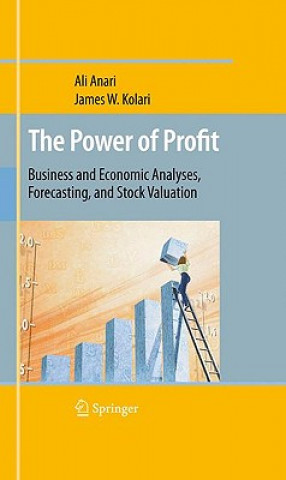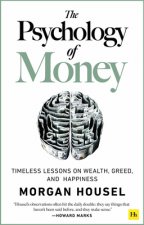
Kod: 01420443
Power of Profit
Autor Ali Anari, James W. Kolari
How can business leaders make better production and capital investment decisions? How can Wall Street analysts improve their predictions of future stock market values? How can government improve macroeconomic forecasts and policie ... więcej
- Język:
 Angielski
Angielski - Oprawa: Twarda
- Liczba stron: 180
Wydawca: Springer-Verlag New York Inc., 2009
- Więcej informacji o książce

121.07 €

Dostępna u dostawcy w małych ilościach
Wysyłamy za 13 - 16 dni
Potrzebujesz więcej egzemplarzy?Jeżeli jesteś zainteresowany zakupem większej ilości egzemplarzy, skontaktuj się z nami, aby sprawdzić ich dostępność.
Dodaj do schowka
Zobacz książki o podobnej tematyce
-

Objective Proficiency Workbook with Answers with Audio CD
12.90 € -14 % -

Doba jedová 4
11.29 € -2 % -

Eric Carle - German
6.75 € -9 % -

Sailor Moon Vol. 7
11.29 € -7 % -

Angličtina bez bariér pro 3.ročník základní školy
22.69 € -

Networked Publics and Digital Contention
44.38 € -

Škvorecký 80
8.47 € -15 % -

Pete Doherty: My Prodigal Son
12.80 € -18 % -

Piknik na hřbitově
8.47 € -14 % -

Underwater Dogs
20.07 € -4 % -

Čierna kniha
13.11 € -13 % -

Misa Mäsa
10.79 € -24 % -

Route 66
25.62 € -4 % -

Dressmaker
20.88 € -

Mrs Robinson's Disgrace
15.12 € -18 % -

Siebenbürgen zwischen Habsburgermonarchie und Osmanischem Reich
75.16 € -

Regulation of the Power Sector
359.89 € -

Staat - Wirtschaft - Gemeinde.
125.51 € -

Making of an African Working Class
35.40 € -10 % -

Was bedeutet die demografische Entwicklung für Wirtschaft und Gesellschaft in Deutschland?
39.34 € -1 % -

Winter Pollen
23.10 € -18 % -

Future of Our Faith
17.04 € -14 % -

Finanzmarktkrise im UEberblick
87.57 € -2 % -

Die Entwicklung der Exporte und Importe der Bundesrepublik Deutschland von 1991 bis 2010
61.74 € -1 % -

Landscapes
34.30 € -

Mountainbike Touren Gardasee Südwest - Valvestino See, m. 1 CD-ROM
29.45 € -14 % -

Applying Quantitative Bias Analysis to Epidemiologic Data
142.86 € -

Climate Change: Significance for Agriculture and Forestry
186.25 €
Podaruj tę książkę jeszcze dziś
- Zamów książkę i wybierz "Wyślij jako prezent".
- Natychmiast wyślemy Ci bon podarunkowy, który możesz przekazać adresatowi prezentu.
- Książka zostanie wysłana do adresata, a Ty o nic nie musisz się martwić.
Więcej informacji o Power of Profit
Za ten zakup dostaniesz 304 punkty
 Opis
Opis
How can business leaders make better production and capital investment decisions? How can Wall Street analysts improve their predictions of future stock market values? How can government improve macroeconomic forecasts and policies? In The Power of Profit, Anari and Kolari demonstrate how profit measures can be applied as the basis for these and many other applications of economic, policy, financial, and business analysis. The underlying theme of the book is that profitability is the driving force in free market economies. Firms invest in capital, produce goods and services, and generate sales in an effort to reap profits. Firms that are unprofitable exit the marketplace and are replaced by profitable firms. Despite the crucial importance of profits, however, there is no formal model that directly relates profits to capital formation and output. Previous studies over the past 100 years on profit and the economy are mainly descriptive in nature, without any well-specified model grounded in microeconomic theory. Filling this gap, the authors present a profit system model of the firm grounded in basic accounting relationships in addition to the well-known Cobb-Douglas production function, which can be applied to individual firms, industries, and the business sector as a whole. §Through rigorous data analysis, the authors show how the profit system modelcan be applied to: §modeling the U.S. business sector and national economy§forecasting output, capital stock, total profit, profit rates, and profit margins §examining the relationships among profitability, economic growth, and the business cycle§simulating the effects of potential monetary policy changes on the business sector and national economy§valuing the Standard & Poor s stock market index as well as individual firms.§The result is a model that integrates microeconomic and macroeconomic factors and that can be widely applied in business and economic decisions, policymaking, research, and teaching.How can business leaders make better production and capital investment decisions? How can Wall Street analysts improve their predictions of future stock market values? How can government improve macroeconomic forecasts and policies? In The Power of Profit, Anari and Kolari demonstrate how profit measures can be applied as the basis for these and many other applications of economic, policy, financial, and business analysis. The underlying theme of the book is that profitability is the driving force in free market economies. Firms invest in capital, produce goods and services, and generate sales in an effort to reap profits. Firms that are unprofitable exit the marketplace and are replaced by profitable firms. Despite the crucial importance of profits, however, there is no formal model that directly relates profits to capital formation and output. Previous studies over the past 100 years on profit and the economy are mainly descriptive in nature, without any well-specified model grounded in microeconomic theory. Filling this gap, the authors present a profit system model of the firm grounded in basic accounting relationships in addition to the well-known Cobb-Douglas production function, which can be applied to individual firms, industries, and the business sector as a whole. §Through rigorous data analysis, the authors show how the profit system model§can be applied to: §modeling the U.S. business sector and national economy§forecasting output, capital stock, total profit, profit rates, and profit margins §examining the relationships among profitability, economic growth, and the business cycle§simulating the effects of potential monetary policy changes on the business sector and national economy§valuing the Standard & Poor s stock market index as well as individual firms§The result is a model that integrates microeconomic and macroeconomic factors and that can be widely applied in business and economic decisions, policymaking, research, and teaching.
 Szczegóły książki
Szczegóły książki
121.07 €
- Pełny tytuł: Power of Profit
- Podtytuł: Business and Economic Analyses, Forecasting, and Stock Valuation
- Autor: Ali Anari, James W. Kolari
- Język:
 Angielski
Angielski - Oprawa: Twarda
- Liczba stron: 180
- EAN: 9781441906489
- ISBN: 1441906487
- ID: 01420443
- Wydawca: Springer-Verlag New York Inc.
- Waga: 444 g
- Wymiary: 243 × 166 × 18 mm
- Data wydania: 01. December 2009
Ulubione w innej kategorii
-

The Book of Bill
23.70 € -14 % -

Gravity Falls Journal 3
16.44 € -23 % -

Berserk Deluxe Volume 1
44.38 € -11 % -

Pumpkin Spice Cafe
10.28 € -28 % -

Berserk Deluxe Volume 2
52.25 € -

White Nights
3.93 € -15 % -

48 Laws Of Power
17.95 € -9 % -

It ends with us
8.67 € -19 % -

Atomic Habits
19.26 € -16 % -

A Little Life
17.55 € -

Berserk Deluxe Volume 3
48.82 € -3 % -

The 48 Laws of Power
24.51 € -5 % -

Jujutsu Kaisen, Vol. 23
10.69 € -18 % -

Surrounded by Idiots
10.48 € -12 % -

Berserk Deluxe Volume 4
45.19 € -10 % -

English File Fourth Edition Intermediate (Czech Edition)
24.31 € -12 % -

Gilmore Girls: The Official Advent Calendar
28.85 € -18 % -

Iron Flame
16.23 € -18 % -

The Official Stardew Valley Cookbook
22.39 € -19 % -

Chainsaw Man, Vol. 16
10.69 € -18 % -

Nexus: A Brief History of Information Networks from the Stone Age to AI
19.16 € -3 % -

A Curse For True Love
10.38 € -12 % -

Berserk Deluxe Volume 5
50.44 € -

A Good Girl's Guide to Murder
8.16 € -14 % -

English File: Pre-Intermediate: Student's Book with Online Practice
24.31 € -12 % -

Little Stranger
16.64 € -2 % -

The Husky and His White Cat Shizun: Erha He Ta de Bai Mao Shizun (Novel) Vol. 6
16.23 € -19 % -

English File Fourth Edition Elementary Workbook with Answer Key
17.34 € -

Psychology of Money
18.86 € -4 % -

It Starts with Us
10.69 € -17 % -

Twisted Lies
9.78 € -17 % -

Berserk Deluxe Volume 6
51.14 € -

English File Fourth Edition Pre-Intermediate Multipack A
19.56 € -11 % -

Twisted Hate
10.18 € -14 % -

Powerless
10.48 € -12 % -

Court of Mist and Fury
9.37 € -21 % -

English File: Intermediate. Workbook with Key
17.34 € -

English File: Intermediate: Student's Book with Online Practice
25.62 € -7 % -

Reckless
9.37 € -21 % -

Twisted Love
9.78 € -17 % -

English File Upper Intermediate Student's Book with Student Resource Centre Pack (4th)
44.08 € -4 % -

Gravity Falls: Lost Legends
17.75 € -15 % -

Twisted Games
9.78 € -17 % -

Headway: Elementary: Student's Book with Online Practice
24.91 € -8 % -

Kid's Box New Generation Level 1 Activity Book with Digital Pack British English
11.49 € -

Court of Thorns and Roses
9.27 € -19 % -

A is for Alien: An ABC Book (20th Century Studios)
5.84 € -19 % -

Everything I Know About Love
9.78 € -31 % -

Vagabond (VIZBIG Edition), Vol. 1
24.51 € -13 %
Osobní odběr Bratislava a 2642 dalších
Copyright ©2008-24 najlacnejsie-knihy.sk Wszelkie prawa zastrzeżonePrywatnieCookies


 Vrácení do měsíce
Vrácení do měsíce Zdarma od 49.99 €
Zdarma od 49.99 € 02/210 210 99 (8-15.30h)
02/210 210 99 (8-15.30h)